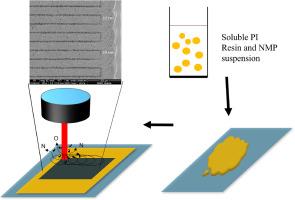通过皮秒脉冲激光诱导可溶性聚酰亚胺悬浮液的转化直接写入石墨烯/石墨泡沫
IF 3.9
Q2 MATERIALS SCIENCE, MULTIDISCIPLINARY
引用次数: 0
摘要
我们报告了利用激光诱导聚酰亚胺(PI)树脂薄膜在玻璃表面的转化,直接写入具有高导电性的石墨烯/石墨泡沫。对处理过的表面进行的拉曼光谱分析表明,900 至 1500 kW/cm2 的平均激光辐照功率可将聚酰亚胺薄膜转化为以石墨烯为主的几层薄膜,而辐照功率超过 1500 kW/cm2 时,辐照功率的增加会导致石墨化(多层石墨烯)材料的形成。转化薄膜的电导率介于 5800±750 S m-1 (低功率辐照)和 1250±300 S m-1 (高激光功率辐照)之间。扫描电子显微镜成像显示,转化后的材料在光滑的顶层和底层之间形成了闭孔泡沫形态。结果表明,对聚酰亚胺悬浮膜进行热处理,然后用超短脉冲激光照射,可形成具有高导电性的闭孔石墨烯/石墨泡沫。孔隙率、密度和薄膜电导率可用于估算不同功率下激光处理薄膜中固相的电导率。激光诱导将 PI 悬浮液转化为石墨烯/石墨泡沫有利于增材制造,可直接打印基于石墨泡沫的三维部件。本文章由计算机程序翻译,如有差异,请以英文原文为准。

Direct Writing of graphene/graphitic foam through picosecond pulsed laser-induced transformation of soluble polyimide suspension
We report the direct writing of graphene/graphitic foam with high electrical conductivity using laser-induced-transformation of polyimide (PI) resin films on glass surfaces. Raman spectroscopy of the treated surfaces indicated that average laser power irradiation between 900 and 1500 kW/cm2 transformed the PI film into a few layered graphene-dominated film, and the increase in irradiation power above 1500 kW/cm2 led to the formation of graphitic (multilayered graphene) material. The electrical conductivity of the transformed film was between 5800±750 S m-1 (lower power irradiation) and 1250±300 S m-1 (higher laser power irradiation). SEM imaging showed that the transformed material has a closed cell foam morphology enclosed between the smooth top and bottom layers. The results indicate that heat treatment of the polyimide suspension films, and subsequent ultra-short, pulsed laser irradiation resulted in a closed-cell graphene/graphitic foam with high electrical conductivity. The pore aspect ratio, density, and film conductivity are used to estimate the conductivity of the solid phases in the laser-treated films at different powers. Laser-induced transformation of the PI suspension into graphene/graphitic foam is conducive to additive manufacturing and may enable the direct printing of graphitic foam-based three-dimensional components.
求助全文
通过发布文献求助,成功后即可免费获取论文全文。
去求助
来源期刊

Carbon Trends
Materials Science-Materials Science (miscellaneous)
CiteScore
4.60
自引率
0.00%
发文量
88
审稿时长
77 days
 求助内容:
求助内容: 应助结果提醒方式:
应助结果提醒方式:


